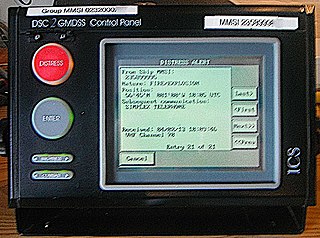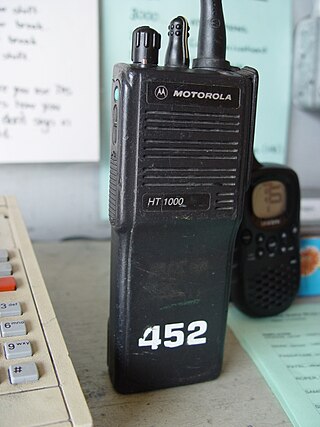Related Research Articles

Very high frequency (VHF) is the ITU designation for the range of radio frequency electromagnetic waves from 30 to 300 megahertz (MHz), with corresponding wavelengths of ten meters to one meter. Frequencies immediately below VHF are denoted high frequency (HF), and the next higher frequencies are known as ultra high frequency (UHF).

An emergency position-indicating radiobeacon (EPIRB) is a type of emergency locator beacon for commercial and recreational boats, a portable, battery-powered radio transmitter used in emergencies to locate boaters in distress and in need of immediate rescue. In the event of an emergency, such as a ship sinking or medical emergency onboard, the transmitter is activated and begins transmitting a continuous 406 MHz distress radio signal, which is used by search-and-rescue teams to quickly locate the emergency and render aid. The signal is detected by satellites operated by an international consortium of rescue services, COSPAS-SARSAT, which can detect emergency beacons anywhere on Earth transmitting on the distress frequency of 406 MHz. The satellites calculate the position or utilize the GPS coordinates of the beacon and quickly passes the information to the appropriate local first responder organization, which performs the search and rescue. As Search and Rescue approach the search areas, they use Direction Finding (DF) equipment to locate the beacon using the 121.5 MHz homing signal, or in newer EPIRBs, the AIS location signal. The basic purpose of this system is to help rescuers find survivors within the so-called "golden day" during which the majority of survivors can usually be saved. The feature distinguishing a modern EPIRB, often called GPIRB, from other types of emergency beacon is that it contains a GPS receiver and broadcasts its position, usually accurate within 100 m (330 ft), to facilitate location. Previous emergency beacons without a GPS can only be localized to within 2 km (1.2 mi) by the COSPAS satellites and relied heavily upon the 121.5 MHz homing signal to pin-point the beacons location as they arrived on scene.

A radiotelephone, abbreviated RT, is a radio communication system for conducting a conversation; radiotelephony means telephony by radio. It is in contrast to radiotelegraphy, which is radio transmission of telegrams (messages), or television, transmission of moving pictures and sound. The term is related to radio broadcasting, which transmit audio one way to listeners. Radiotelephony refers specifically to two-way radio systems for bidirectional person-to-person voice communication between separated users, such as CB radio or marine radio. In spite of the name, radiotelephony systems are not necessarily connected to or have anything to do with the telephone network, and in some radio services, including GMRS, interconnection is prohibited.

Digital Radio Mondiale is a set of digital audio broadcasting technologies designed to work over the bands currently used for analogue radio broadcasting including AM broadcasting—particularly shortwave—and FM broadcasting. DRM is more spectrally efficient than AM and FM, allowing more stations, at higher quality, into a given amount of bandwidth, using xHE-AAC audio coding format. Various other MPEG-4 codecs and Opus are also compatible, but the standard now specifies xHE-AAC.
A distress signal, also known as a distress call, is an internationally recognized means for obtaining help. Distress signals are communicated by transmitting radio signals, displaying a visually observable item or illumination, or making a sound audible from a distance.
The International Telecommunication Union uses an internationally agreed system for classifying radio frequency signals. Each type of radio emission is classified according to its bandwidth, method of modulation, nature of the modulating signal, and type of information transmitted on the carrier signal. It is based on characteristics of the signal, not on the transmitter used.

Marine VHF radio is a worldwide system of two way radio transceivers on ships and watercraft used for bidirectional voice communication from ship-to-ship, ship-to-shore, and in certain circumstances ship-to-aircraft. It uses FM channels in the very high frequency (VHF) radio band in the frequency range between 156 and 174 MHz, inclusive, designated by the International Telecommunication Union as the VHF maritime mobile band. In some countries additional channels are used, such as the L and F channels for leisure and fishing vessels in the Nordic countries. Transmitter power is limited to 25 watts, giving them a range of about 100 kilometres.
The Global Maritime Distress and Safety System (GMDSS) is a worldwide system for automated emergency signal communication for ships at sea developed by the United Nations' International Maritime Organization (IMO) as part of the SOLAS Convention.

Digital selective calling or DSC is a standard for transmitting predefined digital messages via the medium-frequency (MF), high-frequency (HF) and very-high-frequency (VHF) maritime radio systems. It is a core part of the Global Maritime Distress Safety System (GMDSS).

Professional mobile radio are person-to-person two-way radio voice communications systems which use portable, mobile, base station, and dispatch console radios. PMR radio systems are based on such standards as MPT-1327, TETRA, APCO 25, and DMR which are designed for dedicated use by specific organizations, or standards such as NXDN intended for general commercial use. These systems are used by police, fire, ambulance, and emergency services, and by commercial firms such as taxis and delivery services. Most systems are half-duplex, in which multiple radios share a common radio channel, and only one can transmit at a time. Transceivers are normally in receive mode, the user presses a push-to-talk button on his microphone when he wants to talk, which turns on his transmitter and turns off his receiver. They use channels in the VHF and UHF bands, giving them a limited range, usually 3 to 20 miles depending on terrain. Output power is typically limited to 4 watts. Repeaters installed on tall buildings, hills or mountain peaks are used to increase the range of systems.
Maritime identification digits are used by radio communication facilities to identify their home country or base area in Digital Selective Calling (DSC), Automatic Transmitter Identification System (ATIS), and Automatic Identification System (AIS) messages as part of their Maritime Mobile Service Identities. The International Telecommunication Union facilitates the assignment of MIDs to countries. Note that not all countries have MIDs; those without are typically landlocked, with no access to international waters. Sorting MID assignments in numerical order reveals a regional structure, with the first digit:
A Maritime Mobile Service Identity (MMSI) is effectively a maritime object's international maritime telephone number, a temporarily assigned UID, issued by that object's current flag state.

The automatic identification system (AIS) is an automatic tracking system that uses transceivers on ships and is used by vessel traffic services (VTS). When satellites are used to receive AIS signatures, the term Satellite-AIS (S-AIS) is used. AIS information supplements marine radar, which continues to be the primary method of collision avoidance for water transport. Although technically and operationally distinct, the ADS-B system is analogous to AIS and performs a similar function for aircraft.

Most countries' amateur radio licences allow licensed operators to install and use radio transmission equipment while at sea. Such operation is known as maritime mobile amateur radio. In most cases the operator's call sign needs to be extended by adding the suffix "/MM" when transmitting at sea.

The radio frequency 2182 kHz is one of the international calling and distress frequencies for maritime radiocommunication in a frequency band allocated to the mobile service on first priority ("primary") basis, exclusively for distress and calling operations.
An international distress frequency is a radio frequency that is designated for emergency communication by international agreement.

Radio is the technology of signaling and communicating using radio waves. Radio waves are electromagnetic waves of frequency between 3 hertz (Hz) and 3,000 gigahertz (GHz). They are generated by an electronic device called a transmitter connected to an antenna which radiates the waves, and received by another antenna connected to a radio receiver. Radio is widely used in modern technology, in radio communication, radar, radio navigation, remote control, remote sensing, and other applications.
Automated Maritime Telecommunications System (AMTS) is a commercial mobile radio service used within the United States. It operates within the VHF frequency range, just above the North American Band III television range, and offers both voice and data communications to maritime customers. The system is operated by a network of private carriers across the country, with coverage primarily including coastal and inland waterways.
Digital mobile radio (DMR) is a digital radio standard for voice and data transmission in non-public radio networks. It was created by the European Telecommunications Standards Institute (ETSI), and is designed to be low-cost and easy to use. DMR, along with P25 phase II and NXDN are the main competitor technologies in achieving 6.25 kHz equivalent bandwidth using the proprietary AMBE+2 vocoder. DMR and P25 II both use two-slot TDMA in a 12.5 kHz channel, while NXDN uses discrete 6.25 kHz channels using frequency division and TETRA uses a four-slot TDMA in a 25 kHz channel.
References
- 1 2 Khan, Raq; Chang, James. "ATIS Licensing FAQ". Radiocommunications licences. Ofcom. Archived from the original on 24 December 2012. Retrieved 5 December 2012.
- 1 2 ETSI Secretariat (December 2009). Part 1: Technical characteristics and methods of measurement (PDF). ETSI EN 300 698-1: Electromagnetic compatibility and Radio spectrum Matters (ERM); Radio telephone transmitters and receivers for the maritime mobile service operating in the VHF bands used on inland waterways (Report). ETSI.
- ↑ Consultative Committee on International Radio Secretariat (1990). Report 1159: Characteristics of an Automated Identification System for VHF and UHF Transmitting Stations in the Maritime Mobile Service (PDF) (Report). International Telecommunication Union. pp. 150–158.